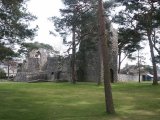
A brief history of Cross Kirk
This religious house is said to have its origins in the discovery (in 1261) of a cross with the relics of the 4th century St. Nicholas of Myra.
Tradition says that Alexander III (1241-1286) was the founder of "The Church of the Holy Cross" in 1261 (although the first definite mention of it is in 1296). In that year, says John of Fordun, a cross was found at Peebles, and near the cross an urn, with the relics of the martyr St Nicholas, supposed to have been massacred in the reign of Diocletian. Crowds of people flocked to the spot, and many miracles were performed. After the reformation of 1560 the church became a parish church, but its roof was removed in 1784 when a new church was built elsewhere.
The monastery was founded for the TRINITARIANS whose order was created towards the end of the 12th century at Cerfroid in France. Its original aim was to obtain the release of Christians captured by the Saracens during the crusades. The order continued to exist after this need passed. There were seven (7) "Trinitarian houses" in Scotland, and the only other one with structural remains is at Dunbar. The unusual position of the monastery on the north side of the church is thought to be due to the fact that the niche containing the relics of St Nicholas was on the south wall of the church. The space opposite this side of the church would naturally be the resort of the crowds of pilgrims who resorted thither twice a year, at the Feast of the Exaltation of the Cross, and again at the Feast of the Finding of the Cross (which had been grafted on to the old pagan Beltane). The south side would therefore have been an inconvenient site for the monastery. Indeed, the practice of veneration continued long after the Reformation, and as late as 1601 the Minister and Bailies of Peebles report to the Presbytery that at this Beltane "there was no resorting of the people into the Cross Church to commit any sign of superstition there." Connected with the monastery was an almshouse and chapel of the Virgin. This almshouse formed a branch establishment of the principal hostel at Eshiels, near Horsburgh Castle-the Hospital of SS. Leonard and Lawrence, which provided for the pilgrims who journeyed to Peebles from the east.
The church was a simple rectangular building with no division(s) between
the monastic choir and the nave. In the 15th century however a bell
tower was added at the west end, which also served as an entrance porch.
The monastic buildings were arranged around three (3) sides of a cloister
on the north side of the church of which little more than the foundations
survive. In 1656, when in use for a parish worship, the church was shortened
by cutting of the monastic choir. In the same period a number of burial
aisles were built along the sides of the church for prominent local
families. The only ones still surviving were built for the Earls of
March (on the north side) and the Earls of Morton on the south side
(the later was more recently used by the Erskines of Venlaw.)